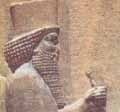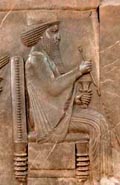Ariadne:
Resources for Athenaze
Chapter13 |
Images |
Ancient Persia
Clicking on the thumbnail will open a new browser window.

 |
The Persian Empire was founded by Cyrus the Great (559-529 BCE), who united the Medes and the Persians, conquered Lydia (546 BCE) and Babylonia (539 BCE) and allowed the Jews in Babylon to return home to Israel. To the left is his tomb near Pasargadae, visited by Alexander the Great in 324. According to the Greek historian Arrian, Cyrus was buried in a gold sarcophagus, and surrounded by arms, jewellery, and a cloak. |
 |
Cyrus' tomb at Pasargadae is set on a fertile plain near his palace. This photo shows the River Pulvar that waters the valley. By clicking on the image, you will see a panorama of the plain, including the remains of the palace and the tomb. |
 |
Darius (522-486 BCE), after defeating Gaumata (who was impersonating Cambyses' brother Bardiya), putting down rebellions in Elam and elsewhere, and marrying Cyrus' daughter Atossa, consolidated the Achaemenid empire. |
| The Behistun Rock inscription, located on a cliff 300 feet above one of the main travel routes, records how Darius, led by the god Ahuramazda, defeated the the usurper Gaumata and won military victories that helped him secure the throne of Persia. |
|
 |
One of Darius' achievements was the building of two capitals, one at Susa and the other at Persepolis (pictured here). Persepolis was built on a platform 450 m x 300 m. and contained a great audience hall (Apadana) that could hold more than 1000 guests. |
 |
The Apadana, the Great Audience Hall, consisted of 72 interior columns, each supporting a roof twenty-five meters high! The founding inscription reads:
Darius the great king, king of kings, king of countries, son of Hystaspes, an Achaemenian, built this palace. |
 |
The Persian empire was a multicultural empire of more than two dozen different ethnoi (nations). The eastern stairs of the Apadana depict loyal subjects from all over the empire bringing tribute to the Great King. Close-ups of each nation can be seen here. |
 |
While other Near Eastern monarchs depicted themselves as victorious in battle and successful in hunting, the Persian Kings were more interested in their presentation as peaceful rulers. Thus, the audience scene becomes the standard iconography of the palace. In this photo (click to enlarge), the king is seated on a throne on a raised dais holding a staff and a lotus flower. His heir Xerxes, also on the dais, and two members of the royal court stand behind him. The king is greeted by a Mede who wears trousers, a tunic, and a round felt hat who greets the king with deference. Persian soldiers frame the scene. |
 |
An invaluable archive of inscribed tablets and seals was found in 1933 by excavators from the Oriental Institute. These tablets were inscribed in Elamite and Aramaic primarily, but they also feature Old Persian and Greek texts. Collectively, these tablets and seals provide a glimpse into the economic and administrative organization of this far-flung empire. If you click on the seal to the left, you will see samples of the tablets. |
Visit More images of Persepolis (livius.org)
Images of Persepolis (Oriental Institute, Chicago)
Image credits: Behistun inscription, crystalinks.com.
3-D reconstruction of royal palace at Persepolis, crystalinks.com.
Relief of subjects bringing gifts, Eastern Stairs, Apadana, Persepolis, Wikimedia Commons.
Sealed Administrative Tablet, Persepolis Fortification Archives, Oriental Institute.
Audience relief of Persepolis, 5th century BCE, Archaeological Museum, Teheran.
All other images, Jona Lendering, livius.org